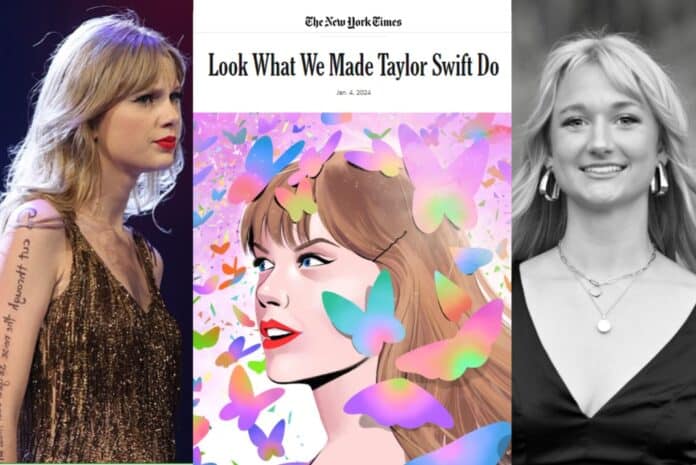In Swiftie jargon, the word “Gaylor” is used to describe ultra-invested creeps who grasp at any attempt to out Taylor Swift as gay or at least bisexual. This falsified rumor has followed Taylor around since 2014 and has been shut down by not only herself and her team but also her history of dating strictly men. Now, the New York Times has published a 5,000-word essay to back this “Gaylor” theory, complete with weaponizing her support for the LGBTQ community and twisting her bare lyricism to fit their narrative.
Now, before all the Gen X Facebook dwellers like to attack Taylor Swift and her fans with poetic comments like “Who cares?” and “She’s satanic!”, I’d like to take a step back and analyze the message that is really being brought to light with this article: Fit into the agenda, or they will make you fit.
Gaylor
In 2014, the “Gaylor” theory was born when Taylor Swift found a close friendship with supermodel Karlie Kloss after performing at the Victoria’s Secret Fashion Show in 2013 and 2014. Theories began to swirl around a homosexual relationship between the two friends, proving that even when Taylor would swear off dating in an attempt to halt the public slut-shaming in tabloids and social media, the public would still find ways to sexualize her very existence.
Taylor writes about this experience in the prologue of her re-released 1989 album, saying,
“Being a consummate optimist, I assumed I could fix this [slut-shaming] if I simply changed my behavior. I swore off dating and decided to focus on myself, my music, my growth, and my female friendships. If I only hung out with my female friends, people couldn’t sensationalize or sexualize that- right? I would learn later that people could and people would.”
After months of a close, public friendship that would result in a betrayal of trust on Kloss’s behalf, leading to the purchase of Swift’s masters by Scooter Braun, their friendship seemingly ended, written of the betrayal, Swift included the lyrics “When the words of a sister//come back in whispers//the proof she was not //in fact what she seemed// not a twin from your dreams//she’s a crook who was caught” in her 2021 album evermore.
Many readers know that I am a Taylor Swift fan. And while this New York Times article and most of my conversational points are about Taylor Swift, the principle of the article goes so much deeper than the article itself.
One of the many reasons Taylor Swift has received backlash from the political right is due to her support of LGBTQ matters, releasing flamboyant music videos, and utilizing her base to fight for purposes she believes in. She has said of her activism: “I didn’t realize until recently that I could advocate for a community that I’m not a part of.”
She was very clearly killing any rumor of labeled sexuality before the rumors could even begin- but not even that was enough for the ever-hungry LGBTQ mob and their woke agendas. Her support has now been twisted and used against her, making one of the most prominent “allies” now a victim of their media brigade; her well-meaning stances taken advantage of.
Had this New York Times piece been angled towards a gay celebrity and positioned to argue their straightness to the world, the New York Times building would have been set on fire. It would have been labeled as homophobic, disrespectful, and an invasion of privacy. The very idea of dismaying someone’s identity in today’s culture is outlandish and punishable- except for when it is dismaying or disrespecting an identity that is straight, white, and traditional.
This new revelation of social justice warriors reminds me of the reverse racism we’re seeing in the news cycles as well. With “people of color-only” playtime and non-white “multicultural centers” in colleges, it is clear that what was once a justified and necessary movement based on real equality has turned into a supremacy initiative- and along with it, hatred and belittlement of those who don’t conform. I’d like to call it heterophobia.
At what point do the ultra-liberal figures, as many see Taylor Swift to be, become not liberal enough? This story has proven that one cannot simply be an ally of the LGBTQ to be accepted or even enough for pop culture- one must be fully submerged in the ideology.
Table of Contents
































